Raphael
Italian painter and architect
Introduction
Italian in full Raffaello Sanzio
born April 6, 1483, Urbino, Duchy of Urbino 【Italy】
died April 6, 1520, Rome, Papal States 【Italy】
 master painter and architect of the Italian High Renaissance. Raphael is best known for his Madonnas (see photograph-->
master painter and architect of the Italian High Renaissance. Raphael is best known for his Madonnas (see photograph--> ) and for his large figure compositions in the Vatican in Rome. His work is admired for its clarity of form and ease of composition and for its visual achievement of the Neoplatonic ideal of human (humanism) grandeur.
) and for his large figure compositions in the Vatican in Rome. His work is admired for its clarity of form and ease of composition and for its visual achievement of the Neoplatonic ideal of human (humanism) grandeur.Early years at Urbino.
Raphael was the son of Giovanni Santi and Magia di Battista Ciarla; his mother died in 1491. His father was, according to the 16th-century artist and biographer Giorgio Vasari (Vasari, Giorgio), a painter “of no great merit.” He was, however, a man of culture who was in constant contact with the advanced artistic ideas current at the court of Urbino. He gave his son his first instruction in painting, and, before his death in 1494, when Raphael was 11, he had introduced the boy to humanistic philosophy at the court.
Urbino had become a centre of culture during the rule of Duke Federico da Montefeltro, who encouraged the arts and attracted the visits of men of outstanding talent, including Donato Bramante (Bramante, Donato), Piero della Francesca, and Leon Battista Alberti, to his court. Although Raphael would be influenced by major artists in Florence and Rome, Urbino constituted the basis for all his subsequent learning. Furthermore, the cultural vitality of the city probably stimulated the exceptional precociousness of the young artist, who, even at the beginning of the 16th century, when he was scarcely 17 years old, already displayed an extraordinary talent.
Apprenticeship at Perugia.
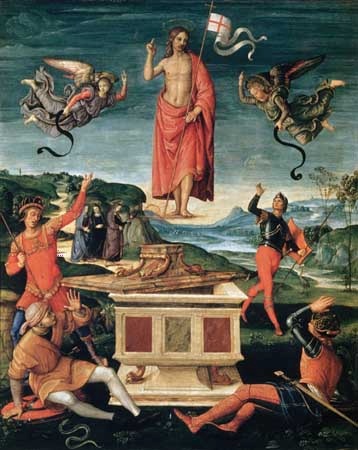 The date of Raphael's arrival in Perugia is not known, but several scholars place it in 1495. The first record of Raphael's activity as a painter is found there in a document of Dec. 10, 1500, declaring that the young painter, by then called a “master,” was commissioned to help paint an altarpiece to be completed by Sept. 13, 1502. It is clear from this that Raphael had already given proof of his mastery, so much so that between 1501 and 1503 he received a rather important commission—to paint the “Coronation of the Virgin” for the Oddi Chapel in the church of San Francesco, Perugia (and now in the Vatican Museum, Rome). The great Umbrian master Pietro Perugino (Perugino) was executing the frescoes in the Collegio del Cambio at Perugia between 1498 and 1500, enabling Raphael, as a member of his workshop, to acquire extensive professional knowledge.
The date of Raphael's arrival in Perugia is not known, but several scholars place it in 1495. The first record of Raphael's activity as a painter is found there in a document of Dec. 10, 1500, declaring that the young painter, by then called a “master,” was commissioned to help paint an altarpiece to be completed by Sept. 13, 1502. It is clear from this that Raphael had already given proof of his mastery, so much so that between 1501 and 1503 he received a rather important commission—to paint the “Coronation of the Virgin” for the Oddi Chapel in the church of San Francesco, Perugia (and now in the Vatican Museum, Rome). The great Umbrian master Pietro Perugino (Perugino) was executing the frescoes in the Collegio del Cambio at Perugia between 1498 and 1500, enabling Raphael, as a member of his workshop, to acquire extensive professional knowledge.In addition to this practical instruction, Perugino's calmly exquisite style also influenced Raphael. The “Giving of the Keys to St. Peter,” painted in 1481–82 by Perugino for the Sistine Chapel of the Vatican Palace in Rome, inspired Raphael's first major work, “The Marriage of the Virgin” (1504; Brera Gallery, Milan). Perugino's influence is seen in the emphasis on perspectives, in the graded relationships between the figures and the architecture, and in the lyrical sweetness of the figures. Nevertheless, even in this early painting, it is clear that Raphael's sensibility was different from his teacher's. The disposition of the figures is less rigidly related to the architecture, and the disposition of each figure in relation to the others is more informal and animated. The sweetness of the figures and the gentle relation between them surpasses anything in Perugino's work.
Three small paintings done by Raphael shortly after “The Marriage of the Virgin”—“Vision of a Knight,” “Three Graces,” and “St. Michael”—are masterful examples of narrative painting, showing, as well as youthful freshness, a maturing ability to control the elements of his own style. Although he had learned much from Perugino, Raphael by late 1504 needed other models to work from; it is clear that his desire for knowledge was driving him to look beyond Perugia.
Move to Florence.
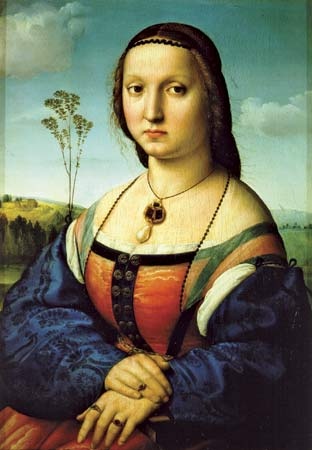 Vasari vaguely recounts that Raphael followed the Perugian painter Bernardino Pinturicchio to Siena and then went on to Florence, drawn there by accounts of the work that Leonardo da Vinci and Michelangelo were undertaking in that city. By the autumn of 1504 Raphael had certainly arrived in Florence. It is not known if this was his first visit to Florence, but, as his works attest, it was about 1504 that he first came into substantial contact with this artistic civilization, which reinforced all the ideas he had already acquired and also opened to him new and broader horizons. Vasari records that he studied not only the works of Leonardo, Michelangelo, and Fra Bartolomeo, who were the masters of the High Renaissance, but also “the old things of Masaccio,” a pioneer of the naturalism that marked the departure of the early Renaissance from the Gothic.
Vasari vaguely recounts that Raphael followed the Perugian painter Bernardino Pinturicchio to Siena and then went on to Florence, drawn there by accounts of the work that Leonardo da Vinci and Michelangelo were undertaking in that city. By the autumn of 1504 Raphael had certainly arrived in Florence. It is not known if this was his first visit to Florence, but, as his works attest, it was about 1504 that he first came into substantial contact with this artistic civilization, which reinforced all the ideas he had already acquired and also opened to him new and broader horizons. Vasari records that he studied not only the works of Leonardo, Michelangelo, and Fra Bartolomeo, who were the masters of the High Renaissance, but also “the old things of Masaccio,” a pioneer of the naturalism that marked the departure of the early Renaissance from the Gothic.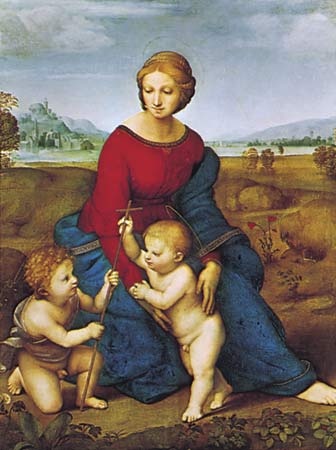
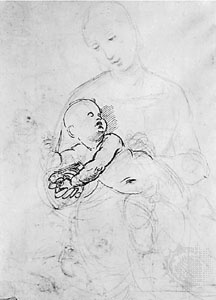 Still, his principal teachers in Florence were Leonardo and Michelangelo. Many of the works that Raphael executed in the years between 1505 and 1507, most notably a great series of Madonnas (Madonna) including “The Madonna of the Goldfinch” (c. 1505; Uffizi Gallery, Florence), the “Madonna del Prato” (c. 1505; Kunsthistorisches Museum, Vienna), the “Esterházy Madonna” (c. 1505–07; Museum of Fine Arts, Budapest), and “La Belle Jardinière” (c. 1507; Louvre Museum, Paris), are marked by the influence of Leonardo, who since 1480 had been making great innovations in painting. Raphael was particularly influenced by Leonardo's “Madonna and Child with St. Anne” pictures, which are marked by an intimacy and simplicity of setting uncommon in 15th-century art. Raphael learned the Florentine method of building up his composition in depth with pyramidal figure masses; the figures are grouped as a single unit, but each retains its own individuality and shape. A new unity of composition and suppression of inessentials distinguishes the works he painted in Florence. Raphael also owed much to Leonardo's lighting techniques; he made moderate use of Leonardo's chiaroscuro (i.e., strong contrast between light and dark), and he was especially influenced by his sfumato (i.e., use of extremely fine, soft shading instead of line to delineate forms and features). Raphael went beyond Leonardo, however, in creating new figure types whose round, gentle faces reveal uncomplicated and typically human sentiments but raised to a sublime perfection and serenity.
Still, his principal teachers in Florence were Leonardo and Michelangelo. Many of the works that Raphael executed in the years between 1505 and 1507, most notably a great series of Madonnas (Madonna) including “The Madonna of the Goldfinch” (c. 1505; Uffizi Gallery, Florence), the “Madonna del Prato” (c. 1505; Kunsthistorisches Museum, Vienna), the “Esterházy Madonna” (c. 1505–07; Museum of Fine Arts, Budapest), and “La Belle Jardinière” (c. 1507; Louvre Museum, Paris), are marked by the influence of Leonardo, who since 1480 had been making great innovations in painting. Raphael was particularly influenced by Leonardo's “Madonna and Child with St. Anne” pictures, which are marked by an intimacy and simplicity of setting uncommon in 15th-century art. Raphael learned the Florentine method of building up his composition in depth with pyramidal figure masses; the figures are grouped as a single unit, but each retains its own individuality and shape. A new unity of composition and suppression of inessentials distinguishes the works he painted in Florence. Raphael also owed much to Leonardo's lighting techniques; he made moderate use of Leonardo's chiaroscuro (i.e., strong contrast between light and dark), and he was especially influenced by his sfumato (i.e., use of extremely fine, soft shading instead of line to delineate forms and features). Raphael went beyond Leonardo, however, in creating new figure types whose round, gentle faces reveal uncomplicated and typically human sentiments but raised to a sublime perfection and serenity.In 1507 Raphael was commissioned to paint the “Deposition of Christ” that is now in the Borghese Gallery in Rome. In this work, it is obvious that Raphael set himself deliberately to learn from Michelangelo the expressive possibilities of human anatomy. But Raphael differed from Leonardo and Michelangelo, who were both painters of dark intensity and excitement, in that he wished to develop a calmer and more extroverted style that would serve as a popular, universally accessible form of visual communication.
Last years in Rome.
 Raphael was called to Rome toward the end of 1508 by Pope Julius II at the suggestion of the architect Donato Bramante. At this time Raphael was little known in Rome, but the young man soon made a deep impression on the volatile Julius and the papal court, and his authority as a master grew day by day. Raphael was endowed with a handsome appearance and great personal charm in addition to his prodigious artistic talents, and he eventually became so popular that he was called “the prince of painters.”
Raphael was called to Rome toward the end of 1508 by Pope Julius II at the suggestion of the architect Donato Bramante. At this time Raphael was little known in Rome, but the young man soon made a deep impression on the volatile Julius and the papal court, and his authority as a master grew day by day. Raphael was endowed with a handsome appearance and great personal charm in addition to his prodigious artistic talents, and he eventually became so popular that he was called “the prince of painters.”Raphael spent the last 12 years of his short life in Rome. They were years of feverish activity and successive masterpieces. His first task in the city was to paint a cycle of frescoes in a suite of medium-sized rooms in the Vatican (Vatican palace) papal apartments in which Julius himself lived and worked; these rooms are known simply as the Stanze. The Stanza della Segnatura (1508–11) and Stanza d'Eliodoro (1512–14) were decorated practically entirely by Raphael himself; the frescoes in the Stanza dell'Incendio (1514–17), though designed by Raphael, were largely executed by his numerous assistants and pupils.
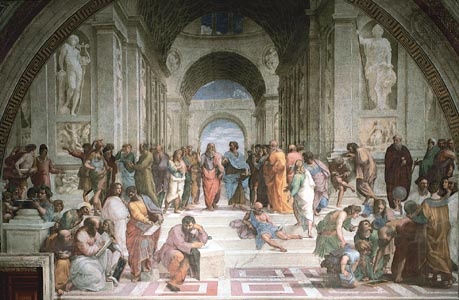 The decoration of the Stanza della Segnatura was perhaps Raphael's greatest work. Julius II was a highly cultured man who surrounded himself with the most illustrious personalities of the Renaissance. He entrusted Bramante with the construction of a new basilica of St. Peter to replace the original 4th-century church; he called upon Michelangelo to execute his tomb and compelled him against his will to decorate the ceiling of the Sistine Chapel; and, sensing the genius of Raphael, he committed into his hands the interpretation of the philosophical scheme of the frescoes in the Stanza della Segnatura. This theme was the historical justification of the power of the Roman Catholic church through Neoplatonic philosophy.
The decoration of the Stanza della Segnatura was perhaps Raphael's greatest work. Julius II was a highly cultured man who surrounded himself with the most illustrious personalities of the Renaissance. He entrusted Bramante with the construction of a new basilica of St. Peter to replace the original 4th-century church; he called upon Michelangelo to execute his tomb and compelled him against his will to decorate the ceiling of the Sistine Chapel; and, sensing the genius of Raphael, he committed into his hands the interpretation of the philosophical scheme of the frescoes in the Stanza della Segnatura. This theme was the historical justification of the power of the Roman Catholic church through Neoplatonic philosophy.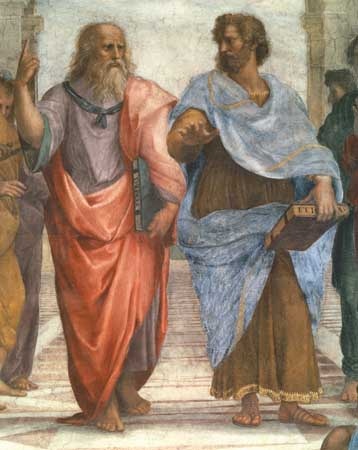 The four main walls in the Stanza della Segnatura are occupied by the frescoes “Disputa” and the “School of Athens” on the larger walls and the “Parnassus” and “Cardinal Virtues” on the smaller walls. The two most important of these frescoes are the “Disputa” and the “School of Athens.” The “Disputa,” showing a celestial vision of God and his prophets and apostles above a gathering of representatives, past and present, of the Roman Catholic church, equates through its iconography the triumph of the church and the triumph of truth. The “School of Athens” is a complex allegory of secular knowledge, or philosophy, showing Plato and Aristotle surrounded by philosophers, past and present, in a splendid architectural setting; it illustrates the historical continuity of Platonic thought. The “School of Athens” is perhaps the most famous of all Raphael's frescoes, and one of the culminating artworks of the High Renaissance. Here Raphael fills an ordered and stable space with figures in a rich variety of poses and gestures, which he controls in order to make one group of figures lead to the next in an interweaving and interlocking pattern, bringing the eye to the central figures of Plato and Aristotle at the converging point of the perspectival space. The space in which the philosophers congregate is defined by the pilasters and barrel vaults of a great basilica that is based on Bramante's design for the new St. Peter's in Rome. The general effect of the fresco is one of majestic calm, clarity, and equilibrium.
The four main walls in the Stanza della Segnatura are occupied by the frescoes “Disputa” and the “School of Athens” on the larger walls and the “Parnassus” and “Cardinal Virtues” on the smaller walls. The two most important of these frescoes are the “Disputa” and the “School of Athens.” The “Disputa,” showing a celestial vision of God and his prophets and apostles above a gathering of representatives, past and present, of the Roman Catholic church, equates through its iconography the triumph of the church and the triumph of truth. The “School of Athens” is a complex allegory of secular knowledge, or philosophy, showing Plato and Aristotle surrounded by philosophers, past and present, in a splendid architectural setting; it illustrates the historical continuity of Platonic thought. The “School of Athens” is perhaps the most famous of all Raphael's frescoes, and one of the culminating artworks of the High Renaissance. Here Raphael fills an ordered and stable space with figures in a rich variety of poses and gestures, which he controls in order to make one group of figures lead to the next in an interweaving and interlocking pattern, bringing the eye to the central figures of Plato and Aristotle at the converging point of the perspectival space. The space in which the philosophers congregate is defined by the pilasters and barrel vaults of a great basilica that is based on Bramante's design for the new St. Peter's in Rome. The general effect of the fresco is one of majestic calm, clarity, and equilibrium.About the same time, probably in 1511, Raphael painted a more secular subject, the “Triumph of Galatea” in the Villa Farnesina in Rome; this work was perhaps the High Renaissance's most successful evocation of the living spirit of classical antiquity. Meanwhile, Raphael's decoration of the papal apartments continued after the death of Julius in 1513 and into the succeeding pontificate of Leo X until 1517. In contrast to the generalized allegories in the Stanza della Segnatura, the decorations in the second room, the Stanza d'Eliodoro, portray specific miraculous events in the history of the Christian church. The four principal subjects are “The Expulsion of Heliodorus from the Temple,” “The Mass at Bolsena,” “The Liberation of St. Peter,” and “Leo I Halting Attila.” These frescoes are deeper and richer in colour than are those in the earlier room, and they display a new boldness on Raphael's part in both their dramatic subjects and their unusual effects of light. “The Liberation of St. Peter,” for example, is a night scene and contains three separate lighting effects—moonlight, the torch carried by a soldier, and the supernatural light emanating from an angel. Raphael delegated his assistants to decorate the third room, the Stanze dell'Incendio, with the exception of one fresco, the “Fire in the Borgo,” in which his pursuit of more dramatic pictorial incidents and his continuing study of the male nude are plainly apparent.
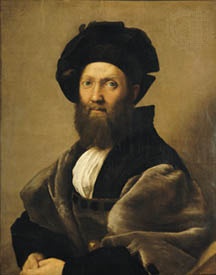 The Madonnas that Raphael painted in Rome show him turning away from the serenity and gentleness of his earlier works in order to emphasize qualities of energetic movement and grandeur. His “Alba Madonna” (1508; National Gallery, Washington, D.C.) epitomizes the serene sweetness of the Florentine Madonnas but shows a new maturity of emotional expression and supreme technical sophistication in the poses of the figures. It was followed by the “Madonna di Foligno” (1510; Vatican Museum) and the “Sistine Madonna” (1513; Gemäldegalerie, Dresden), which show both the richness of colour and new boldness in compositional invention typical of Raphael's Roman period. Some of his other late Madonnas, such as the “Madonna of Francis I” (Louvre), are remarkable for their polished elegance. Besides his other accomplishments, Raphael became the most important portraitist in Rome during the first two decades of the 16th century. He introduced new types of presentation and new psychological situations for his sitters, as seen in the portrait of “Leo X with Two Cardinals” (1517–19; Pitti Palace, Florence). Raphael's finest work in the genre is perhaps the “Portrait of Baldassare Castiglione” (1516; Louvre), a brilliant and arresting character study.
The Madonnas that Raphael painted in Rome show him turning away from the serenity and gentleness of his earlier works in order to emphasize qualities of energetic movement and grandeur. His “Alba Madonna” (1508; National Gallery, Washington, D.C.) epitomizes the serene sweetness of the Florentine Madonnas but shows a new maturity of emotional expression and supreme technical sophistication in the poses of the figures. It was followed by the “Madonna di Foligno” (1510; Vatican Museum) and the “Sistine Madonna” (1513; Gemäldegalerie, Dresden), which show both the richness of colour and new boldness in compositional invention typical of Raphael's Roman period. Some of his other late Madonnas, such as the “Madonna of Francis I” (Louvre), are remarkable for their polished elegance. Besides his other accomplishments, Raphael became the most important portraitist in Rome during the first two decades of the 16th century. He introduced new types of presentation and new psychological situations for his sitters, as seen in the portrait of “Leo X with Two Cardinals” (1517–19; Pitti Palace, Florence). Raphael's finest work in the genre is perhaps the “Portrait of Baldassare Castiglione” (1516; Louvre), a brilliant and arresting character study.Leo X commissioned Raphael to design 10 large tapestries to hang on the walls of the Sistine Chapel. Seven of the ten cartoons (full-size preparatory drawings) were completed by 1516, and the tapestries woven after them were hung in place in the chapel by 1519. The tapestries themselves are still in the Vatican, while seven of Raphael's original cartoons are in the British royal collection and are on view at the Victoria and Albert Museum in London. These cartoons represent “Christ's Charge to Peter,” “The Miraculous Draught of Fishes,” “The Death of Ananias,” “The Healing of the Lame Man,” “The Blinding of Elymas,” “The Sacrifice at Lystra,” and “St. Paul Preaching at Athens.” In these pictures Raphael created prototypes that would influence the European tradition of narrative history painting for centuries to come. The cartoons display Raphael's keen sense of drama, his use of gestures and facial expressions to portray emotion, and his incorporation of credible physical settings from both the natural world and that of ancient Roman architecture (Western architecture).
While he was at work in the Stanza della Segnatura, Raphael also did his first architectural work, designing the church of Sant' Eligio degli Orefici. In 1513 the banker Agostino Chigi, whose Villa Farnesina Raphael had already decorated, commissioned him to design and decorate his funerary chapel in the church of Santa Maria del Popolo. In 1514 Leo X chose him to work on the basilica of St. Peter's (Saint Peter's Basilica) alongside Bramante; and when Bramante died later that year, Raphael assumed the direction of the work, transforming the plans of the church from a Greek, or radial, to a Latin, or longitudinal, design.
Raphael was also a keen student of archaeology and of ancient Greco-Roman sculpture, echoes of which are apparent in his paintings of the human figure during the Roman period. In 1515 Leo X put him in charge of the supervision of the preservation of marbles bearing valuable Latin inscriptions; two years later he was appointed commissioner of antiquities for the city, and he drew up an archaeological map of Rome. Raphael had by this time been put in charge of virtually all of the papacy's various artistic projects in Rome, involving architecture, paintings and decoration, and the preservation of antiquities.
Raphael's last masterpiece is the “Transfiguration” (commissioned by Cardinal Giulio de' Medici in 1517), an enormous altarpiece that was unfinished at his death and completed by his assistant Giulio Romano. It now hangs in the Vatican Museum. “The Transfiguration” is a complex work that combines extreme formal polish and elegance of execution with an atmosphere of tension and violence communicated by the agitated gestures of closely crowded groups of figures. It shows a new sensibility that is like the prevision of a new world, turbulent and dynamic; in its feeling and composition it inaugurated the Mannerist movement and tends toward an expression that may even be called Baroque.
Raphael died on his 37th birthday. His funeral mass was celebrated at the Vatican, his “Transfiguration” was placed at the head of the bier, and his body was buried in the Pantheon in Rome.
Additional Reading
Monographs focusing on the artist's life include Johann David Passavant, Raphael of Urbino and His Father Giovanni Santi (1872, reprinted 1978); J.A. Crowe and G.B. Cavalcaselle, Raphael: His Life and Works, 2 vol. (1882–85, reprinted 1972); James Beck, Raphael (1976), recounting the development of his early career; and Roger Jones and Nicholas Penny, Raphael (1983), which includes a treatment of his architecture. Texts that discuss his work in detail include Oskar Fischel, Raphael, 2 vol. (1948; reissued in 1 vol., 1964); Pierluigi de Vecchi, The Complete Paintings of Raphael (1966, reissued 1987), containing a general catalog of the artist's works; The Complete Work of Raphael (1969, reprinted 1978), with 7 essays on all his artistic output and more than 900 reproductions; John Pope-Hennessy, Raphael (1970); Luitpold Dussler, Raphael: A Critical Catalogue of His Pictures, Wall-Paintings, and Tapestries (1971); Paul Joannides, The Drawings of Raphael: With a Complete Catalogue (1983), containing more than 400 reproductions; James H. Beck (ed.), Raphael Before Rome (1986), scholarly symposium papers on his early career; and Francis Ames-Lewis, The Draftsman Raphael (1986). Also noteworthy are Leopold D. Ettlinger and Helen S. Ettlinger, Raphael (1987); Carlo Pedretti, Raphael: His Life & Work in the Splendors of the Italian Renaissance (1989); Jacqueline Guillaud and Maurice Guillaud, Raphael: Grace of an Angel, Force of Genius: Frescoes from the Vatican (1989); James H. Beck, Raphael (1994).
archangel
in the Bible and the Qurʾān, one of the archangels. In the Old Testament apocryphal Book of Tobit, he is the one who, in human disguise and under the name of Azarias (“Yahweh helps”), accompanied Tobias in his adventurous journey and conquered the demon Asmodeus. He is said (Tobit 12:15) to be “one of the seven holy angels 【archangels】 who present the prayers of the saints and enter into the presence of the glory of the Holy One.” In the pseudepigraphal Book of Enoch, Raphael is “the angel of the spirits of men,” and it is his business to “heal the earth which the angels 【i.e., the fallen angels】 have defiled.” The archangels are referred to as numbering seven (e.g., Revelation 8:2 and Tobit 7:15), and are listed in Enoch 1:20 as Uriel, Raphael, Raguel, Michael, Sariel, Gabriel, and Remiel. Raphael is reckoned among the saints in both Eastern and Western churches, his feast day being October 24.
- Egyptian Museum
- Egyptian Museum and Papyrus Collection
- Egyptian religion
- Egyptian wildcat
- Egyptology
- eHarmony
- E H Carr
- Ehime
- Ehlers-Danlos syndrome
- E H Palmer
- Ehrenberg, Christian Gottfried
- Ehrenburg, Ilya Grigoryevich
- Ehrenfels, Christian, Freiherr (baron) von
- Ehrenfest, Paul
- Ehringsdorf remains
- Ehrlich, Eugen
- Ehrlichman, John D.
- Ehrlich, Paul
- Ehrlich, Paul R
- Ehud
- Ehud Barak
- Ehud Olmert
- Eh–pH diagram
- Eibar
- Eichelberger, Robert L